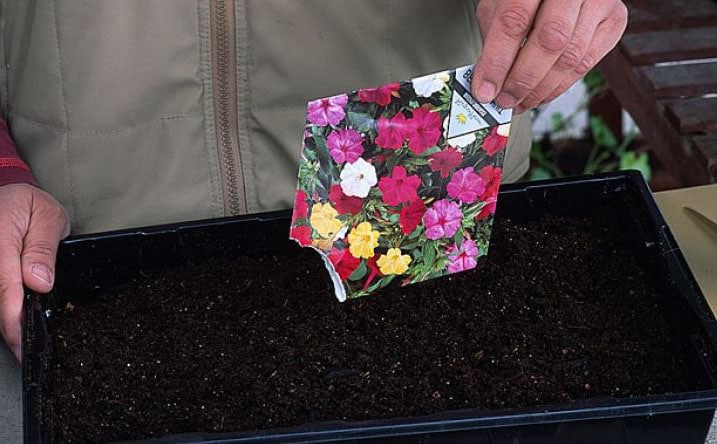When to sow the petunias?
The petunia can be planted in the ground, as soon as the risk of frost has no more reason to be, in April and May.
Which varieties to choose?
There are about forty species of single or double flower petunias. Most of those grown are hybrids with two-tone flowers and various colors.
Petunias are classified into 4 major groups:
- Multiflora petunias with medium flowers;
- Petunias grandiflora with large flowers;
- Petunias Miliflora small flowers very numerous and resistant to the rain;
- The drooping petunias, better known under their trade name Surfinia, Fortunia … and used either as ground cover or in suspensions and trays.
Calibrachoa is not strictly speaking a petunia, but on the other hand, it has the same qualities and is cultivated in the same way. He is actually from the genus Petunia and his split.
The Grandiflora hybrid petunia It flowers in the form of large flowers that can be up to 10 cm in diameter and can be double or single. It measures between 20 and 40 cm and is the most sold in gardening. He is very sensitive to rain.
The multiflora hybrid petunia it measures between 30 and 40 cm and offers flowers whose diameter is usually 5 cm, they can be single or double. It has a bushy habit and is very floriferous. It also resists perfectly to bad weather.
The Surfinia : it can measure up to 2 meters in length, it has flowers of all sizes. It is very floriferous, annual or biennial and its growth is rapid. It has a climbing port.
The Supertunia : its length is 80 cm to one meter. Its flowers are medium with a diameter of 5 cm and they have a nice pink hue. It is very floriferous and its port is creeping or falling. It is highly resistant to drought and heat and requires little maintenance.
Calibrachoa It flowers in the form of very small flowers and has a height of 15 to 35 cm. Its growth is fast and it gives a lot of flowers. It has a sloping or creeping port and is grown as an annual.
The Million Bells It is quite low since it oscillates between 15 and 25 cm for a length up to 60 cm. Its flowers are small with a diameter of 3 cm. It has a creeping and falling port.
>> To read also: Planting the petunia: when and how?
What to do before sowing the petunias?

Before planting or sowing your petunias, prepare the soil. You hoe it and you remove all the roots, weeds, pebbles or stones that can hinder its rooting and development. It is also recommended to mix the garden soil with potting soil to enrich it.
How to sow them?

1. Plant the petunias in a planter or pot
- Cover the bottom of the pot or planter with clay balls or gravel to ensure drainage, to a thickness of 5 cm.
- Mix potting soil and earth equally.
- Wet the root ball well, then drop it in the hole you made.
- Fill in the interstices, then lightly tamp the soil and water to thoroughly soak the substrate. Then let the water drain properly.
2. Sow the petunia
Sowing is carried out in February or March in hot and terrine :
- Put a draining layer about 2 cm with clay balls or gravel at the bottom of the terrine.
- You then cover with a specially designed potting soil, then tamp and water.
- Sow light and thin and cover the seeds with a thin layer of potting soil.
- Then tamp lightly and cover with a glass plate or a clear lid.
- As soon as you have two or three leaves, replant your plants in pots, but keep them in the shelter.
- The seedlings can be placed in the garden in May or in the ground.
Seeding is still rather delicate, if you are a beginner, turn instead to seedlings in pots.
3. Cutting petunias
- Take a branch with 3 to 5 knots of about 15 cm.
- Remove all the flowers and the bottom leaves on half the height.
- Install this cutting in a soil that you have lightened with a little sand.
- Place it in the shade and warm, the temperature should be at least 20 or 25 ° C.
- Keep your potting soil moist.
Where to plant petunias?
Petunias can be placed indifferently on a balcony or terrace or in open ground, in solid or border.
The most suitable place should be sunny or partial shade and especially sheltered from the wind. The petunia for vibrant colors needs sun and light.
- Petunias are easily put in bushes in the massifs and borders or in large basins.
- The petunia with falling port will be placed in suspensions or balconies.
- The petunia Grandiflora will find its place in massive, planters or pots.
How to maintain them?
You have to put enough fertilizer for flowering plants petunias, because they are extremely greedy plants. It is best to add once or twice a week from June to October.
Faded flowers: they must be removed as and when the appearance of the plant is always aesthetic.
When the flowering period is over, you can then shelter your petunias for the winter, either by returning them for the winter under dry and cool shelter, or with a veil of wintering. You bring them out in the spring. And then you have to put fertilizer in quantity.
Prune your petunias: to avoid unsightly and bare branches, trim some stems as the plant blooms. So you get new ramifications that bring flowers again. Cut about one-third to one-half the height of the stem.
How to water petunias?
The petunias enjoy regular watering, however it is only necessary to wet the foot avoiding flowers and foliage. They dread the water in excess and it is necessary to be very vigilant and to well modulate the watering according to the needs of the plant:
- Petunia in pots or planters requires more water than petunia in the ground.
- Watering depends on the region, the temperature and the season. If you are in a heat wave, water frequently.
- Favor the waterings in the evening.
Harvest petunias: when and how?
The petunia seeds can be harvested at autumn in order to sow them the following year.
Above the flower, you will see the location of the old flowers, it is here that you will find the seeds that hide in bulging capsules. It is necessary to press the small shell of each side to release them.
The seeds are tiny. Place them in a paper envelope and keep it in the house dry.
You can then sow them in pots under the veranda between the end of February and the end of March.
You will then spray them with a sprayer.
Petunia diseases and what to do?
Damping off If the seeds are a little too thin, the substrate is rich in peat or if you water too much, the damping-off may well make its appearance. Seedlings then rot on fairly large areas. To protect the plantations, consider covering the seeds with a layer of 2 to 3 mm thick vermiculite. It is a very light and granular product that is marketed as insulation.
Septoria It is a fungal infection that manifests as brownish spots on the leaves and is then covered with blackheads. To avoid it, horsetail purine is perfect.
Aphids They are the sworn enemies of the petunia as of all the flowers in the garden. The stems and young leaves can be literally invaded by these homopteran insects. It is better to avoid them to install near the nasturtiums which have the property of moving them away.
Slugs They are also fond of petunias, you can pick them up or put beer traps.
Read also :









